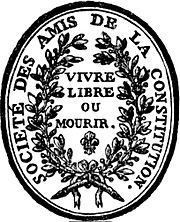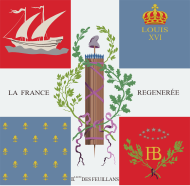
Back Felyanlar Azerbaijani Фельяны Byelorussian Фьойани Bulgarian Feuillant Catalan Feuillanti Czech Feuillanterne Danish Feuillants German Λέσχη των Φεγιαντίνων Greek Club des Feuillants Spanish Feuillanten taldea Basque
Society of the Friends of the Constitution Société des Amis de la Constitution | |
|---|---|
 | |
| President | Antoine Barnave Alexandre de Lameth Adrien Duport |
| Founded | 18 July 1791 |
| Dissolved | 10 August 1792 |
| Merger of | Modéré Jacobins Monarchiens Club de 1789 |
| Succeeded by | Club de Clichy |
| Headquarters | Rue Saint-Honoré, Paris |
| Newspaper | La Gazette |
| Ideology | Moderatism Conservatism[1] Classical liberalism[2] Conservative liberalism[3] Constitutional monarchism[1] |
| Political position | Centre[4] |
| Colours | Blue White (monarchy's colours) |
| Party flag | |
 | |
The Society of the Friends of the Constitution[5] (French: Société des Amis de la Constitution), better known as Feuillants Club (French pronunciation: [fœjɑ̃] French: Club des Feuillants), was a political grouping that emerged during the French Revolution.[6] It came into existence on 16 July 1791.[6] The assembly split between the Feuillants on the right, who sought to preserve the position of the king and supported the proposed plan of the National Constituent Assembly for a constitutional monarchy; and the radical Jacobins on the left, who wished to press for a continuation of the overthrow of Louis XVI. It represented the last and most vigorous attempt of the moderate constitutional monarchists to steer the course of the revolution away from the radical Jacobins.[7]
The Feuillant deputies publicly split with the Jacobins when they published a pamphlet on 16 July 1791, protesting the Jacobin plan to participate in the popular demonstrations against Louis XVI on the Champ de Mars the following day. Initially the group had 264 ex-Jacobin deputies as members, including most of the members of the correspondence committee.
The group held meetings in a former monastery of the Feuillant monks on the Rue Saint-Honoré in Paris and came to be popularly called the Club des Feuillants. They called themselves the Amis de la Constitution. The group was led by Antoine Barnave, Alexandre de Lameth and Adrien Duport.
- ^ a b "Club of the Feuillants". Encyclopædia Britannica. Retrieved 5 April 2021.
- ^ David Andress, ed. (2015). The Oxford Handbook of the French Revolution. OUP Oxford. p. 312.
... This botched escape plan pulled the carpet from underneath the feet of the 'liberal' Feuillant majority of the Constituent Assembly and, in their stead, the surviving extremists of the Jacobin club grabbed hold of the Revolution's ...
- ^ Austin Gill, ed. (1970). Life and Letters in France: The eighteenth century, by R. Fargher. Scribner. p. 204.
... A public career was now open to Chénier, as literary spokesman for the Feuillants the conservative liberal monarchists who , in December 1791, were the largest group in the Legislative Assembly. His devotion to liberty and the ....
- ^ Israel, Jonathan (2014). Revolutionary Ideas: An Intellectual History of the French Revolution from The Rights of Man to Robespierre. Princeton University Press. p. 222.
- ^ It was the original name of the Jacobin Club until his radicalization of Republic's birth.
- ^ a b Chisholm, Hugh, ed. (1911). . Encyclopædia Britannica. Vol. 10 (11th ed.). Cambridge University Press. p. 304.
- ^ Israel, Jonathan (2014). Revolutionary Ideas: An Intellectual History of the French Revolution from The Rights of Man to Robespierre. Princeton University Press. pp. 204–207.
© MMXXIII Rich X Search. We shall prevail. All rights reserved. Rich X Search